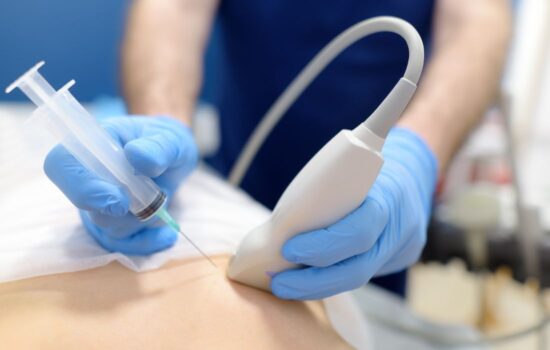August 1, 2025
Making Sense of Your Breast Biopsy

If an abnormality is detected during a mammogram or breast ultrasound, your doctor will recommend further investigation, usually through a biopsy. Understanding what a biopsy is and what the results mean is helpful for understanding what may come next.
What is a Breast Biopsy?
A breast biopsy is an outpatient medical procedure that removes a sample of breast tissue to be examined by a pathologist. This step usually follows a mammogram or other imaging tests that have identified an area of concern in the breast. Images can tell you the size and shape of the lump, but they can’t give you a definitive answer on whether it’s cancerous.
There are several ways to perform a breast biopsy based on the lump’s size, location of the lump in the breast, and the number of areas to be tested. Common types of breast biopsies include:
Fine-needle aspiration biopsy: This procedure uses a thin needle to extract a small number of cells or fluid from a breast lump. If the lump is hard to feel, an ultrasound may help guide the needle.
Core needle biopsy: This method uses a wider needle to remove a larger sample of breast tissue or fluid. Imaging techniques, such as 3-D mammography, ultrasound, or MRI, are often needed to help guide the surgeon to the lump's exact location.
Surgical biopsy: This involves removing tissue during surgery. It might be an incisional biopsy, which removes part of the tumor, or an excisional biopsy, which removes the entire tumor. Surgeons often use a pellet placed inside the breast and other special tools to guide them to the lump during surgery. Wire-guided biopsies are also used with a wire showing the surgeon exactly where to look for the lump.
Lymph node biopsy: If the tumor seems more advanced, the doctor may test nearby lymph nodes. They can be biopsied by using a needle or a lymph node under the arm, closest to the lump, can be removed to check for cancer.
What Your Breast Biopsy Results Mean
After the biopsy, the samples are sent to a lab where a pathologist examines the cells under a microscope. The pathologist's findings are put into a comprehensive report that details important characteristics of the sample. This report includes the size, weight, and color of the tissue, observations about the cells under the microscope, protein tests, cell growth rate, and a diagnosis or summary of the findings. It may also indicate whether the sample is hormone receptor-positive.
Interpreting Breast Biopsy Results for Benign Tumors
Fortunately, most breast biopsy results indicate benign tumors, meaning no cancer was found. If your pathology report comes back cancer-free, you may still receive information describing the benign condition. Terms you may see in your report include:
Cysts
Adenosis
Duct ectasia
Columnar cell change (CCC)
Columnar cell hyperplasia (CCH)
Sclerosing adenosis (SA)
Apocrine metaplasia
Papillomatosis
Fibrocystic breast changes
Collagenous spherulosis (CS)
Columnar alteration with prominent apical snouts and secretions (CAPSS)
Treatment is usually not required unless symptoms are present. Most benign breast conditions do not increase the risk of developing breast cancer in the future. It is important to discuss any concerns about your benign breast biopsy results with your doctor.
Interpreting Breast Biopsy Results for Cancerous Tumors
If breast biopsy results show breast cancer, the pathology report will describe the tumor's characteristics. This typically includes the type of breast cancer, its location, stage (or grade), and whether hormones are influencing its growth. This information is crucial for your breast cancer care team to recommend a suitable treatment plan.
Invasive vs. Non-Invasive Types of Breast Cancer
Breast cancer types are typically classified based on where the cancer began and whether it is invasive or non-invasive.
Invasive (infiltrating) breast cancer: This means the cancer has spread from its original location into nearby tissues. It may start in a milk duct, known as invasive ductal carcinoma, or in the lobe of the breast, called invasive lobular carcinoma (ILC).
Noninvasive (in situ) breast cancer: This describes breast cancer that stays within the milk duct where it began. The report will list this as ductal carcinoma in situ (DCIS), which is considered a pre cancer or stage 0 breast cancer.
Your biopsy may have also detected cancer cells for other types of breast cancer, such as:
Inflammatory breast cancer: A rare type of breast cancer that usually does not form a lump but may cause swelling or reddening of the skin.
Paget’s disease: A rare form of cancer that affects the nipple and areola.
Phyllodes tumors: These tumors start in the connective tissue of the breast. Most are benign, but some can be malignant.
Breast Cancer Grade
Breast cancer grade refers to how different the cancer cells are from healthy cells, indicating whether they are slower or faster-growing:
Grade 1: The cells look slightly different from normal cells and tend to grow slowly.
Grade 2: The cells look noticeably different from normal and grow faster.
Grade 3: The cells appear significantly different from normal cells and grow at a faster rate.
Higher-grade breast cancers often require more intensive treatment compared to lower-grade cancers.
Hormone Receptor Positive or Negative
Pathologists also check the biopsied breast tissue for receptors that attach to estrogen or progesterone hormones, which can cause some cancer cells to grow faster. If the tumor tests positive for hormone receptors, hormone therapy may be recommended as part of your breast cancer treatment plan.
Hormone receptor status is typically reported in various ways:
Using the terms "positive" or "negative" indicates whether hormone receptors are present.
A percentage showing how many cells tested positive for receptors.
An Allred score combines the percentage of cells with receptors and how visible they are. This score ranges from 0 to 8, where a higher number indicates more visible receptors.
Read more about hormone receptor status in breast cancer.
HER2 Status
HER2 (human epidermal growth factor receptor 2) is a protein that influences breast cell growth. If your report says your cancer is HER2 positive, this protein is likely causing it to grow more quickly. If the report shows HER2 status of "equivocal," it means your cancer's HER2 status is unclear, and you may need a second verification test. If one test shows your cancer is HER2 positive, but another test does not, it may be classified as HER2-low.
Biopsy Results Influence Treatment Approaches
The biopsy report, along with other test results, helps determine the breast cancer stage, which can range from 0 to IV. The recommended treatment plan will depend on the type, stage, and grade of the breast cancer, as well as hormone receptors and lymph node involvement. Your breast cancer doctor will talk with you about the best next steps.
Related Reading:
What Is a Breast Pathology Report and How Does It Impact Your Next Steps?

Expert Breast Cancer Care in Brevard County, Florida
The breast cancer doctors at Cancer Care Centers of Brevard offer the latest breast cancer treatments and are here to answer your questions and provide a personalized treatment plan.
If you have recently been diagnosed with breast cancer, schedule a consultation or a second opinion with one of our oncologists in Palm Bay, Rockledge, Melbourne, and Merritt Island, Florida.
Categories: Breast Cancer